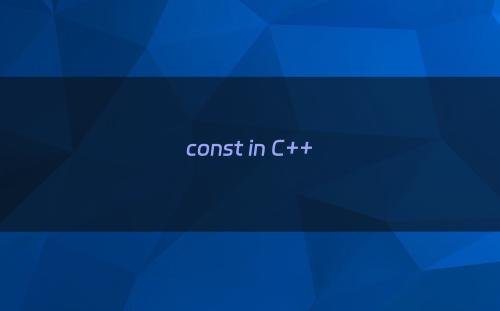C++里的const修饰符,可以修饰一般变量,也可以修饰指针,还可以修饰成员函数。const修饰符的作用,表示某些量不能被修改(modify)。
下面用C++代码说明:

#include <iostream>
using namespace std;
void const_int();
void int_ptr();
void const_int_ptr();
void int_ptr_const();
void const__int_ptr_const();
void m_function_const();
int main()
{
cout << "const是一个左结合的类型修饰符" <<endl<<"-----------------------------"<<endl;
const_int();
const_int_ptr();
int_ptr_const();
const__int_ptr_const();;
m_function_const();
return 0;
}
void const_int()
{
//a是一个常整型数。
const int a = 90;
cout << "const int a = 90 : a是常整型量。 " << endl;
cout << "a = " << a << endl<<"-----------------------------"<<endl;
}
void const_int_ptr()
{
/*--------- const int* ----------*/
//a是一个指向常整型数的指针, 整型数是不可修改的,但指针可以重新指向新的变量。
//content cannot be modified, pointer itself can be modified.
const int* a = new int(11);
cout << "const int* a = new int(11): " << endl;
cout << "指向常整型量的指针 a. " << endl;
cout << "指针的内容不能被修改," << endl;
cout << "但是指针变量本身可以被修改。" << endl;
cout << " *a= " << *a << endl << "-----------------------------" << endl;
delete a; // const in * 与int const* 等价
}
void int_ptr_const()
{
/*------------ int * const --------------*/
//pointer cannot be modified. content of pointer can be modified.
int* const a = new int(22);
cout << "int* const a = new int(22)," << endl;
cout << "a是一个指向整型数的常指针," << endl;
cout << "也就是说,指针的conten是可以修改的," << endl;
cout<< "但指针是不可修改的."<<endl;
cout << "*a = " << *a << endl;
*a = 2288;
cout << "执行语句 *a = 2288 之后:" << endl;
cout << "*a = " << *a<<endl << "-----------------------------" << endl;
delete a;
}
void const__int_ptr_const()
{
/*----------const int * const -----------*/
/* a是一个指向常整型数的常指针,
指针指向的整型 数是不可修改的,
同时指针也是不可修改的。
*/
const int* const a = new int(33);
cout << "const int* const a = new int(33)," << endl;
cout << "const int* const a : 指向常整型数的常指针a. " << endl;
cout << "指针和指针的内容都是不可以修改的。" << endl;
cout << "*a = " << *a << endl << "-----------------------------" << endl;;
delete a;
}
void m_function_const()
{
string str;
str += "void classname::function( )const;\n";
str += "成员函数后面的const, 表示是常成员函数,\n";
str += "常成员函数不会改变成员变量值。\n";
cout << str << endl;
}
void int_ptr()
{
int* a = new int(22);
*a = 122; //the content of pointer can be changed
int b = 11;
a = &b; //the pointer can be changed too.
delete a; //free memory on heap maually.
}
程序输出结果:
const是一个左结合的类型修饰符
-----------------------------
const int a = 90 : a是常整型量。
a = 90
-----------------------------
const int* a = new int(11):
指向常整型量的指针 a.
指针的内容不能被修改,
但是指针变量本身可以被修改。
*a= 11
-----------------------------
int* const a = new int(22),
a是一个指向整型数的常指针,
也就是说,指针的conten是可以修改的,
但指针是不可修改的.
*a = 22
执行语句 *a = 2288 之后:
*a = 2288
-----------------------------
const int* const a = new int(33),
const int* const a : 指向常整型数的常指针a.
指针和指针的内容都是不可以修改的。
*a = 33
-----------------------------
void classname::function( )const;
成员函数后面的const, 表示是常成员函数,
常成员函数不会改变成员变量值。
【结语】本文用C++代码方式,说明了修饰符const用在普通变量、指针、成员函数上的不同涵义。const指针的应用,让程序变得更加清晰易读,是C++中常见的修饰符。掌握这些修饰符,对于新手阅读范例代码,很有帮助。
